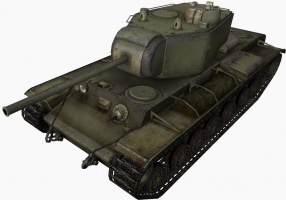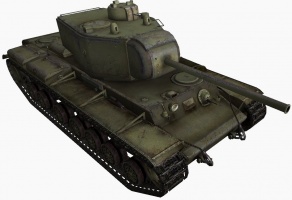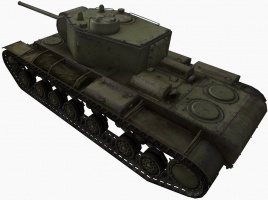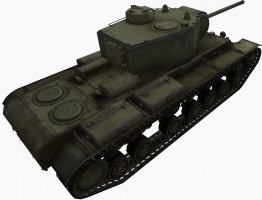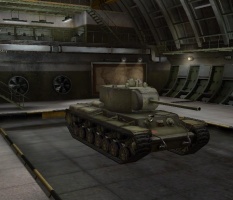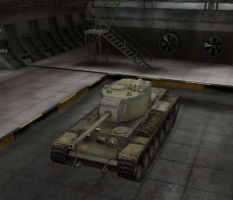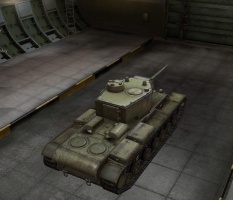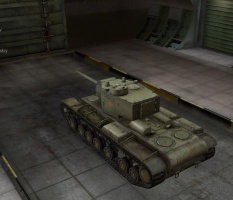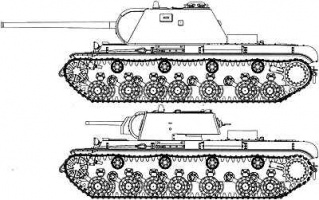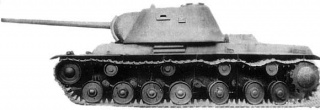KV-3
KV-3
Mouse over "
[Client Values; Actual values in
| 1,390,000 |
| 1300360 HP Hit Points |
| 64.88/68.2530.2/71.8 t Weight Limit |
- Commander
- Gunner
- Radio Operator
- Driver
- Loader
- Loader
| 640750 hp Engine Power |
| 32/10 km/h Speed Limit |
| 1618 deg/s Traverse |
| 9.8624.83 hp/t Power/Wt Ratio |
| NoNo Pivot |
| // mm Hull Armor |
| 100/100/100155/130/130 mm Turret Armor |
AP/APCR/HE
AP/APCR/HE Shells |
109/2800/98
1025/4800/608 Shell Cost |
| 160/160/280390/390/530 HP Damage |
| 120/161/43175/217/61 mm Penetration |
|
11.76 r/m ▲
4.88 r/m Standard Gun ▲ Rate of Fire Standard Gun |
|
1881.6 ▲
Standard Gun
▼
Standard Gun
▲
1903.2 Standard Gun ▲
Standard Gun
▼
Standard Gun
▲ Damage Per Minute Standard Gun |
|
0.42 m ▲
0.44 m With 50% Crew: 0.52 m ▲ Accuracy With 50% Crew: 0.545 m |
| 3.4 s 3.1 s Aim time |
| 2422 deg/s Turret Traverse |
| 360° Gun Arc |
| -7°/+20°-7°/+24° Elevation Arc |
| 11038 rounds Ammo Capacity |
| 1515 % Chance of Fire |
| 330 m 340 m View Range |
| 360 m 730 m Signal Range |
VII
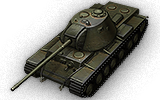
1390000
The KV-3 is a Soviet tier 7 heavy tank.
Developed on the basis of the KV heavy tank, the vehicle initially had very few differences from the mass-produced model. It underwent field trials in January–February 1941. Eventually, several crucial changes were made to the design, greatly boosting the combat characteristics of the vehicle. By July 22, 1941, chassis and engine development was completed. According to some sources, in the fall of 1941, the vehicle was equipped with a serial KV turret and sent to the front.
The KV-3 is defined by its lengthened and more heavily armoured KV chassis, and a much rounder turret design. It can use a large variety of guns, but it's best known for the 122mm D-25T cannon, a weapon it shares with the IS. It sports an impressive 120mm of frontal hull armour, its turret is relatively well-armoured too, and the conical design makes bouncing frequent. When upgraded, it can mount the V-2SN engine, which gives a huge boost of horsepower. It is however much slower than the IS, and like the IS it lacks penetration compared to the German, French and US heavy tanks of its tier.
Modules / Available Equipment and Consumables
Modules
| Tier | Engine | Engine Power (hp) |
Chance of Fire on Impact (%) |
Weight (kg) |
Price (
| |
|---|---|---|---|---|---|---|
| VII | V-2IS | 600 | 15 | 750 | 36000 | |
| VI | V-5 | 640 | 15 | 750 | 27860 | |
| VIII | V-2SN | 750 | 15 | 750 | 34000 |
| Tier | Suspension | Load Limit (т) |
Traverse Speed (gr/sec) |
Rmin | Weight (kg) |
Price (
| |
|---|---|---|---|---|---|---|---|
| VI | KV-3 | 68.25 | 16 | B/2 | 14200 | 10720 | |
| VII | KV-3 Bis | 71.8 | 18 | B/2 | 14200 | 18200 |
| Tier | Radio | Signal Range (m) |
Weight (kg) |
Price (
| |
|---|---|---|---|---|---|
| V | 10R | 360 | 100 | 3660 | |
| VII | 10RK | 440 | 100 | 18600 | |
| IX | 12RT | 625 | 110 | 33600 | |
| X | R-113 | 730 | 80 | 52200 |
Compatible Equipment
Compatible Consumables
Player Opinion
Pros and Cons
Pros:
- Good all-around armour, really tough when angled
- High alpha damage with the 122 mm cannon and above-average DPM
- Great at sidescraping, good gun depression (-7)
- Well sloped Turret armour with auto bounce sides
- Good max speed for its size (V-2SN engine)
Cons:
- Armor is very flat, vulnerable to T8-9 guns
- Low accuracy and sluggish behaviour.
- Bad aiming time (2.97 seconds) and mediocre dispersion (0.42)
- Side of the turret and hull have massive module hitboxes
- Limited penetration, even with APCR
Performance
While the KV-3 has a wide array of weapons to choose from, there are really one two options worth considering. 107 mm ZiS-6 is the first one in the line and is probably already researched as it was available in the T-150. The 107 mm has less alpha damage than the 122 mm guns and does slightly less DPM as well, but has a more forgiving reload time and has cheap ammo. The 122 mm D-25T is simply more powerful than the 107 mm and has slightly better penetration. The increased power of the HE rounds should also not be overlooked, as they make a reasonable (and cheaper) alternative to APCR when facing higher tier opponents you cannot easily pen. However, the gun handles sluggishly due to its size, is the slowest and most inaccurate of the bunch, and its shells are very expensive. If you miss or bounce your shot, it's painful. The 100 mm D10T might look a bit bad on paper, having the lowest alpha and DPM, however, it has the shortest aim time, is the most accurate weapon you can mount, has even lower ammo cost than the 107mm and a higher rate of fire. Being sluggish and unwieldy at first, after mounting the best engine this tank gains mobility and agility more comparable with the IS. Like the majority of heavily armoured tank, its combat performance nowadays strongly depends on the enemy limiting themselves to standard shells, as with gold ammo the KV-3 is just a slow undergunned easy target.
Lacking penetration for all its guns, the KV-3 is most effective up close where other tanks have trouble aiming down on the nearly unsloped frontal hull armour, though the large gun mantlet will now and then be penetrated by lower-tier medium tanks at point-blank range. While the IS has good frontal hull armour which is difficult to improve by angling the hull, the KV-3 has slightly worse frontal armour which is much easier to angle effectively and becomes much more effective than the IS' armour. The upgraded turret might be as tall as a house, but that house can bounce. While the turret cheeks of the IS can be penetrated easily by most guns with 120 penetration or more, the KV-3's cheeks are narrower and extremely sloped.
- Note that the KV-3 was buffed in 1.10.1:
Top gun (122mm D-25T) buffed: Aim time and dispersion buffed from 3.26/0.44 -> 2.97/0.42 +25mm of frontal turret thickness (130 -> 155) along with some reworking to the turret
Early Research
- It is possible to mount all upgraded modules onto the KV-3 without overloading the suspension (provided no additional equipment is mounted), so it is possible to ignore the Suspension until the end. However, the KV-3 is already quite bulky fully-upgraded, and the suspension's added traverse will help.
- The 10RK radio, the 107 mm ZiS-6, and the 85 mm S-31 carry over from the T-150. The V-2IS engine and 122 D-2-5T carries over from the KV-85 if you played that tank prior to this one. The 100 mm D10T carries over if you've previously researched it on the IS, T-44 or Object 416.
- The acceleration on the KV-3 is anaemic with the second turret without the top engine, inferior in hp/ton to the Maus even with the V-21S. Prioritize the research of the V-2SN, which will confer the KV-3 with a stately 11 hp/ton.
- Now you can unlock the second turret and then the 122mm cannons. Consider upgrading the suspension and engine if you haven't done so after unlocking the first 122mm, as the D-25T only offers improved DPM.
- The 100 mm D10T can be ignored entirely unless you wish to elite the tank or intend to play the IS-2-II in the future. You should pick up the top radio before moving on though as it's used on all Russian tier 8-9 tanks.
Suggested Equipment
Gallery
Historical Info
Development and preliminary design
In 1940, the KV-1 and KV-2 tanks were the heavy tanks of the USSR army. Even before the war started, the Soviet military recognized the need for more armour. The KV was only just in mass production, but an order was made for an improved version of it on June 17th, 1940. The tank factory in Kirov was to make 4 prototypes by the end of the year: 2 versions with 90 mm and 2 versions with 100 mm armour. Of the two types, one should be armed with an 85 mm gun, the other with a 76 mm gun.
The factory only managed to complete two of this prototypes: the 90 mm armoured design with a 76 mm gun, basically an up-armoured KV-1 tank, and a 100 mm armoured design with the 85 mm gun. They were respectively called T-150 (or Object 150) and T-220 (or Object 220). Apart from extra armour, the T-150 only differed on some details from the KV-1 (an improved cupola and a new 700 hp engine are the most important changes). The inside of the tank didn't change, as the extra armour was mounted externally. During testing, the T-150 suffered from overheating in higher gears, even though outside temperatures were well below zero degrees centigrade.
The T-220 was a more radical innovation. The hull was lengthened, a wheel was added and a new gun, the 85 mm F-30 main gun, was mounted. The gun was already successfully tested on the T-28 that fall. Testing of the T-220 started at the end of January 1941, but after one day the 700 hp V-5 engine could not cope with the weight of 62 tons and failed.
Despite these problems, orders were received to mass-produce the T-150, under the name KV-3, in March, as the current tanks of the Soviet army were becoming more and more obsolete. However, the factory and the designers chose to concentrate on developing the T-220 instead, now under the name KV-220. The tank was tested extensively and received a new 850 hp diesel engine with supercharger. However, not only the engine was suffering from the weight of 70 tons. Suspension and torsion bars bent and twisted, and the transmission had problems as well. Still, the tank was able to complete nearly 2,000 km of testing before the start of Operation Barbarossa.
The factory started preparation for mass production again but was stopped by the Soviet military. Intelligence showed that the Germans were also designing a heavy tank, so the Soviet design would become even more important. If it failed, the Soviet army would not have an adequate counter to the German threat. This meant the design of the KV-3 was again subject to modification of both hull and turret, and a new gun, the 107 mm ZiS-6, was to be mounted on the tank.
Moreover, new, heavier tanks were demanded, most notably the KV-4 heavy tank. With a design weight of 90 tons, this tank was too heavy to go in production, especially taking into account the problems with the transmission that were plaguing the much lighter KV tank. A KV-5 tank, with a hull height of 0.9 meters, was also ordered, but never got beyond the drawing board. Possibly the most feasible design proposal was the KV-9 heavy assault tank. With a weight of 48 tons, a 122 mm howitzer, and front armour of 135 mm, this was a much more realistic design. Two prototypes of the tank were completed, but the tank never went into mass production. Finally, a turretless prototype, the KV-7, was sent to Moscow for review. The tank-mounted multiple guns and was rejected by Stalin for this reason.
The fate of the prototypes
With the war underway, the KV factories that were experimenting with prototypes focused on mass production of the KV, the only Soviet tank that was truly feared by Germany at the time. The unfinished prototypes were ripped of their experimental turrets and guns and were sent to the front with KV-1 turrets. The T-220 (KV-3) model served under the 124th tank battalion and was destroyed near the Ust-Tosno railway bridge in December 1941. The T-150 was sent to the 123th tank battalion, but its fate is unknown.
Further development of the KV series was halted, but the experience of the testing was used to design the successful IS tank.
Conclusion
The KV was a heavy, slow-moving tank, but the Soviet army wanted something even stronger. That meant all parts had to be more durable and able to cope with more weight. During testing, it showed that the designers did not succeed in developing a reliable, versatile heavy tank based on the KV-tank. Ultimately the projects were stopped and the focus of the Soviet tank designers shifted to developing a tank with reasonable weight, good mobility, and sufficient armour. The IS tank was the logical result of their quest.
Historical Gallery
Historical Accuracy Errata
*There are no known plans that the KV-3 was to be equipped with a 122mm gun















